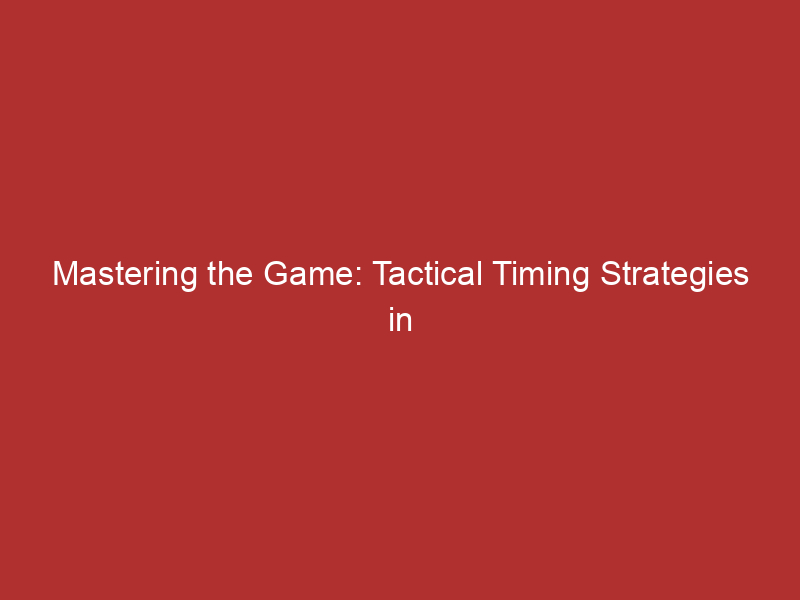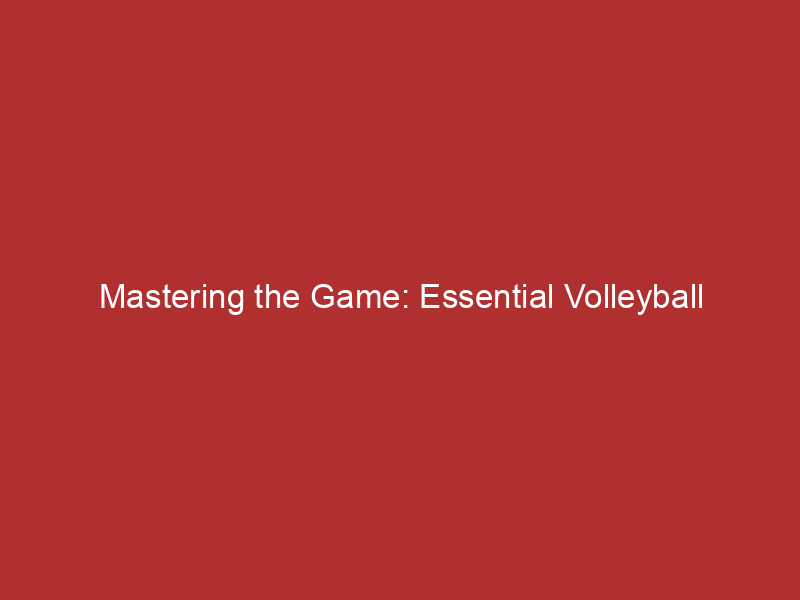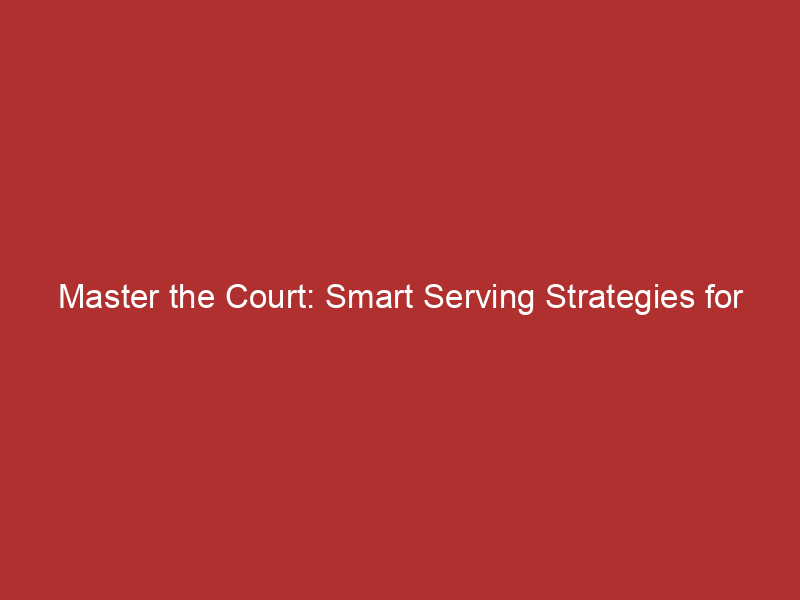
Introduction to Volleyball Strategies
Volleyball, a popular sport worldwide, is not just about physical strength and agility. It also requires strategic planning and tactical timing. In this article, we will delve into the importance of strategies in volleyball and introduce you to the concept of tactical timing.
- Overview of the importance of strategies in volleyball
- Introduction to tactical timing in volleyball
Strategies in volleyball are as crucial as the skills of the players. They can make the difference between winning and losing a game. A well-planned strategy allows a team to maximize their strengths and exploit the weaknesses of the opposing team. It involves positioning players on the court, deciding who serves and when, and determining the best way to return the ball. According to a study by the American Volleyball Coaches Association, teams with a solid game strategy have a 60% higher winning rate.
Tactical timing in volleyball refers to the ability to choose the right moment to execute a particular move or strategy. It involves anticipating the opponent’s actions, reacting swiftly, and making split-second decisions. For example, a player might decide to serve a fast ball when the opposing team least expects it, or a team might choose to execute a complex play at a critical point in the match. Mastering tactical timing can give a team a significant edge over their opponents.
In the following sections, we will delve deeper into the key strategies in volleyball, how to improve your tactical timing, and how to master volleyball timing tactics. So, whether you’re a beginner or a seasoned player, stay tuned for some valuable insights that can help you up your game!
Understanding Tactical Timing in Volleyball
In the dynamic and fast-paced world of volleyball, mastering the concept of tactical timing is crucial. Let’s delve into what this term means and how it manifests in the game.
Definition of Tactical Timing
Tactical timing in volleyball refers to the strategic use of time and speed during a game. It involves making decisions about when to execute certain moves or plays to gain an advantage over the opponent.
- Explanation of what tactical timing in volleyball means: In volleyball, every second counts. The timing of your serve, your jump, or your spike can make the difference between scoring a point or losing one. Tactical timing is all about understanding the rhythm of the game and using it to your advantage. It’s about knowing when to speed up, when to slow down, and when to strike. It’s a skill that requires practice, intuition, and a deep understanding of the game.
- Examples of tactical timing in action: Let’s look at a couple of examples to better understand tactical timing in volleyball.
- Example 1: A player might delay their serve to disrupt the opposing team’s rhythm and concentration, thereby increasing the chances of scoring a point.
- Example 2: A setter might quicken the pace of a set to catch the opposing blockers off guard, creating an opportunity for a successful spike.
Mastering tactical timing in volleyball can significantly enhance a team’s performance and increase their chances of winning. It’s a subtle art that requires practice, but once mastered, it can be a game-changer.
Importance of Tactical Timing
In volleyball, tactical timing is not just about being fast or slow. It’s about making the right move at the right time. This can greatly influence the outcome of a game. Let’s explore how and why.
- How tactical timing can influence the outcome of a game
- Case studies demonstrating the impact of tactical timing
Imagine a volleyball game where both teams are equally skilled. The difference between winning and losing can often come down to who uses tactical timing better. For example, a well-timed serve can catch the opposing team off guard, leading to a point. Similarly, a perfectly timed jump can block an opponent’s spike, turning the tide of the game. In essence, tactical timing can create opportunities for scoring and prevent the opposing team from doing the same.
Let’s look at some real-life examples to understand the power of tactical timing in volleyball.
| Case Study | Impact of Tactical Timing |
|---|---|
| 2016 Olympics Women’s Volleyball Final | The Chinese team, under coach Lang Ping, used tactical timing to their advantage. They timed their spikes and blocks perfectly to win the gold medal against Serbia. |
| 2019 Men’s Volleyball World Cup | The Brazilian team demonstrated excellent tactical timing in their serves and attacks, leading them to victory in the tournament. |
These case studies show that mastering tactical timing can lead to success in high-stakes volleyball games. It’s not just about individual skills, but also about how and when you use them in the game.
In conclusion, tactical timing is a crucial aspect of volleyball strategy. It can make the difference between winning and losing a game. So, if you want to improve your volleyball game, start by understanding and practicing tactical timing.
Key Volleyball Strategies
In the game of volleyball, having a strategic approach can make a significant difference. One of the key strategies that players should master is the concept of smart plays. Let’s delve into this topic further.
Smart Volleyball Plays
Smart plays in volleyball refer to the strategic moves that players make to outsmart their opponents. These plays require a deep understanding of the game, quick decision-making skills, and excellent execution. They are not just about hitting the ball hard, but about hitting it smartly.
- Discussion on the concept of smart plays in volleyball
- Examples of smart plays
- Tip: This is a soft hit over the blockers to an open area of the court. It’s a smart play because it catches the defense off guard, especially if they are expecting a hard hit.
- Quick set: This is a fast-paced play where the setter sets the ball quickly to the hitter, giving the blockers less time to react. It requires excellent timing and coordination between the setter and the hitter.
- Back row attack: In this play, a back row player attacks the ball. It’s a smart play because it adds an extra layer of unpredictability to the offense, making it harder for the defense to block.
Smart plays involve a combination of skills, including serving, passing, setting, attacking, blocking, and defense. The goal is to exploit the weaknesses in the opposing team’s formation or play, forcing them to make errors or creating opportunities for your team to score points. For instance, if a player notices a gap in the opponent’s defense, they might aim their attack there to score a point.
Let’s look at a few examples of smart plays in volleyball:
Mastering smart plays in volleyball requires practice and a deep understanding of the game. However, once you get the hang of it, you’ll find that these strategies can significantly enhance your performance on the court.
Volleyball Timing Tactics
Timing tactics in volleyball are crucial for both offensive and defensive plays. They can be the difference between winning and losing a point, and ultimately, the game. Let’s delve into the specifics of these tactics and see some examples of them in action.
- Explanation of How Timing Tactics are Used in Volleyball
- Examples of Successful Timing Tactics
In volleyball, timing is everything. It’s about synchronizing your movements with your teammates and the ball. On offense, timing tactics can include coordinating your jumps with the setter’s toss to execute a powerful spike. On defense, timing is about predicting the opponent’s moves and positioning yourself to block or dig the ball.
One key aspect of timing in volleyball is the ‘3-step approach’ used by attackers. This involves a specific sequence of steps (right-left-right for right-handed players, left-right-left for left-handed players) timed perfectly with the setter’s toss. This approach allows the attacker to jump and hit the ball at the peak of their jump, maximizing power and control.
Let’s look at some examples of successful timing tactics in volleyball. One of the most famous examples is the ‘quick set.’ This is a fast-paced play where the setter barely touches the ball before the attacker hits it. The speed and timing of this play make it difficult for the opposing team to react in time to block or defend.
Another example is the ‘slide attack.’ In this play, the attacker runs behind the setter and jumps off one foot to hit the ball. This requires precise timing between the setter and the attacker to ensure the ball is hit at the right moment and from the right angle.
Mastering timing tactics in volleyball requires practice and coordination with your team. But once you get the hang of it, you’ll see your game improve significantly. Remember, in volleyball, timing isn’t just about individual skill – it’s about working seamlessly with your team to outsmart and outplay your opponents.
Strategies for Volleyball Plays
When it comes to volleyball, having a strong strategy can make the difference between winning and losing. In this section, we will delve into the world of offensive strategies, exploring their importance and how tactical timing plays a crucial role in their execution.
Offensive Strategies
Offensive strategies in volleyball are designed to put the opposing team on the defensive, creating opportunities for your team to score points. Let’s take a closer look at these strategies and understand the role of tactical timing in them.
- Overview of offensive strategies in volleyball
- Role of tactical timing in offensive strategies
Offensive strategies in volleyball are all about coordination, communication, and timing. The main goal is to find and exploit the weaknesses in the opponent’s defense. Some common offensive strategies include the quick set, the slide, and the back-row attack. Each of these strategies requires a different set of skills and a different approach to timing and execution.
Tactical timing is a critical component of any offensive strategy in volleyball. It’s about knowing when to strike and when to hold back. The perfect timing can catch the opposing team off guard, creating an opportunity for a successful attack. For instance, in a quick set, the setter must accurately time the set so that the hitter can strike the ball as it’s on its way up, not after it has reached its peak. This requires precise coordination and timing between the setter and the hitter.
In conclusion, mastering offensive strategies and understanding the role of tactical timing can significantly improve your team’s performance in volleyball. Remember, practice makes perfect. So, keep practicing these strategies and timing techniques to become a formidable opponent on the volleyball court.
Defensive Strategies
-
Overview of Defensive Strategies in Volleyball
Defensive strategies in volleyball are crucial to a team’s success. They are designed to prevent the opposing team from scoring points. The main goal of these strategies is to return the ball to the opponent’s court, ideally in a way that makes it difficult for them to return it. There are several key defensive strategies used in volleyball, including the following:
- Block: This is a technique used to stop the ball from crossing the net after an opponent’s attack. It requires good timing and positioning.
- Dig: This is a technique used to prevent the ball from hitting the court after an opponent’s attack. It involves a player diving to the ground to keep the ball in play.
- Defensive Formation: This refers to the positioning of players on the court. The most common formations are the 6-2, 5-1, and 4-2, each with its unique advantages.
-
Role of Tactical Timing in Defensive Strategies
Tactical timing plays a significant role in defensive strategies in volleyball. It refers to the ability to anticipate and react to the opponent’s moves in a timely manner. The right timing can make the difference between a successful block or dig and a point for the opposing team.
For example, in blocking, players must time their jump so that they reach the highest point when the ball is just about to cross the net. If they jump too early or too late, they might miss the ball. Similarly, in digging, players must time their dive to reach the ball just before it hits the ground.
Improving tactical timing requires practice and experience. It also involves studying the opponent’s patterns and tendencies, which can provide clues about when and where they are likely to attack.
Improving Your Tactical Timing in Volleyball
Mastering the art of tactical timing in volleyball can significantly improve your game. It can help you anticipate your opponent’s moves, make effective decisions, and execute plays with precision. Let’s delve into some practical training tips and recommended exercises that can help you enhance your tactical timing.
Training Tips
- Practical tips for improving tactical timing
- Recommended exercises and drills
Improving your tactical timing starts with understanding the game’s rhythm. Watch and analyze professional matches to learn how players time their moves. Practice predicting the ball’s trajectory and timing your jumps accordingly. Remember, practice makes perfect. The more you train, the better your timing will become.
Specific exercises can help improve your tactical timing. For instance, ‘shadow drills’ where you mimic the actions of a professional player can be beneficial. Another effective drill is the ‘toss and hit’ exercise. This involves tossing the ball and hitting it at the highest point of your jump, which can help improve your timing. Always remember to warm up before starting any exercise to prevent injuries.
Improving your tactical timing in volleyball is not an overnight process. It requires consistent practice and dedication. However, with the right training tips and exercises, you can significantly enhance your game. Remember, the key to success in volleyball lies in understanding the game’s rhythm and timing your moves accordingly.
Learning from the Pros
Now, let’s take a look at how the professionals do it. By studying their play styles, we can gain valuable insights and learn how to improve our own tactical timing in volleyball.
-
Case Studies of Professional Players with Excellent Tactical Timing
One of the best ways to learn is by observing those who have mastered the game. Let’s explore a few case studies of professional volleyball players who are known for their excellent tactical timing.
Player Team Key Achievements Notable Tactical Timing Skills Kerri Walsh Jennings USA 3-time Olympic gold medalist Exceptional at reading the game and making split-second decisions. Sergey Tetyukhin Russia 4-time Olympic medalist Renowned for his precise timing in both attack and defense. Giba Brazil 3-time Olympic gold medalist Master of timing his jumps and spikes to perfection. -
Key Takeaways from Their Play Styles
By studying these professionals, we can learn some important lessons about tactical timing in volleyball. Here are a few key takeaways:
- Anticipation: All of these players excel at anticipating their opponents’ moves. This allows them to position themselves correctly and make the right play at the right time.
- Decision Making: They are all quick thinkers, making split-second decisions that can change the course of the game. This is a crucial aspect of tactical timing.
- Consistency: These players consistently demonstrate excellent timing, whether they’re serving, spiking, or blocking. This consistency is key to their success.
Conclusion: Mastering Volleyball Timing Tactics
As we wrap up our discussion on volleyball strategies, it’s crucial to revisit the importance of tactical timing in volleyball and how mastering these strategies can elevate your game.
- Summary of the importance of tactical timing in volleyball
- Final thoughts on mastering volleyball strategies
Tactical timing in volleyball is the backbone of every successful play. It’s the difference between a well-executed serve or spike and a missed opportunity. It’s about knowing when to strike, when to block, and when to pass. This timing is not just about physical speed, but also about mental agility. The ability to anticipate the opponent’s move, to read the game, and to make split-second decisions is what separates the good players from the great ones.
Mastering volleyball strategies requires practice, dedication, and a deep understanding of the game. It’s about more than just physical skills; it’s about mental acuity, teamwork, and strategic planning. Remember, every player on the court is a piece of a larger puzzle. Knowing where you fit and how you can contribute to the team’s overall strategy is key. So, keep practicing, keep learning, and keep striving to improve. With time and effort, you can master the art of volleyball timing tactics and take your game to new heights.
In conclusion, volleyball is a game of strategy and timing. The more you understand and master these elements, the better your performance on the court will be. So, take what you’ve learned here today, apply it to your game, and see the difference it makes. Remember, the road to mastery is a journey, not a destination. Keep practicing, keep improving, and most importantly, keep enjoying the game.






